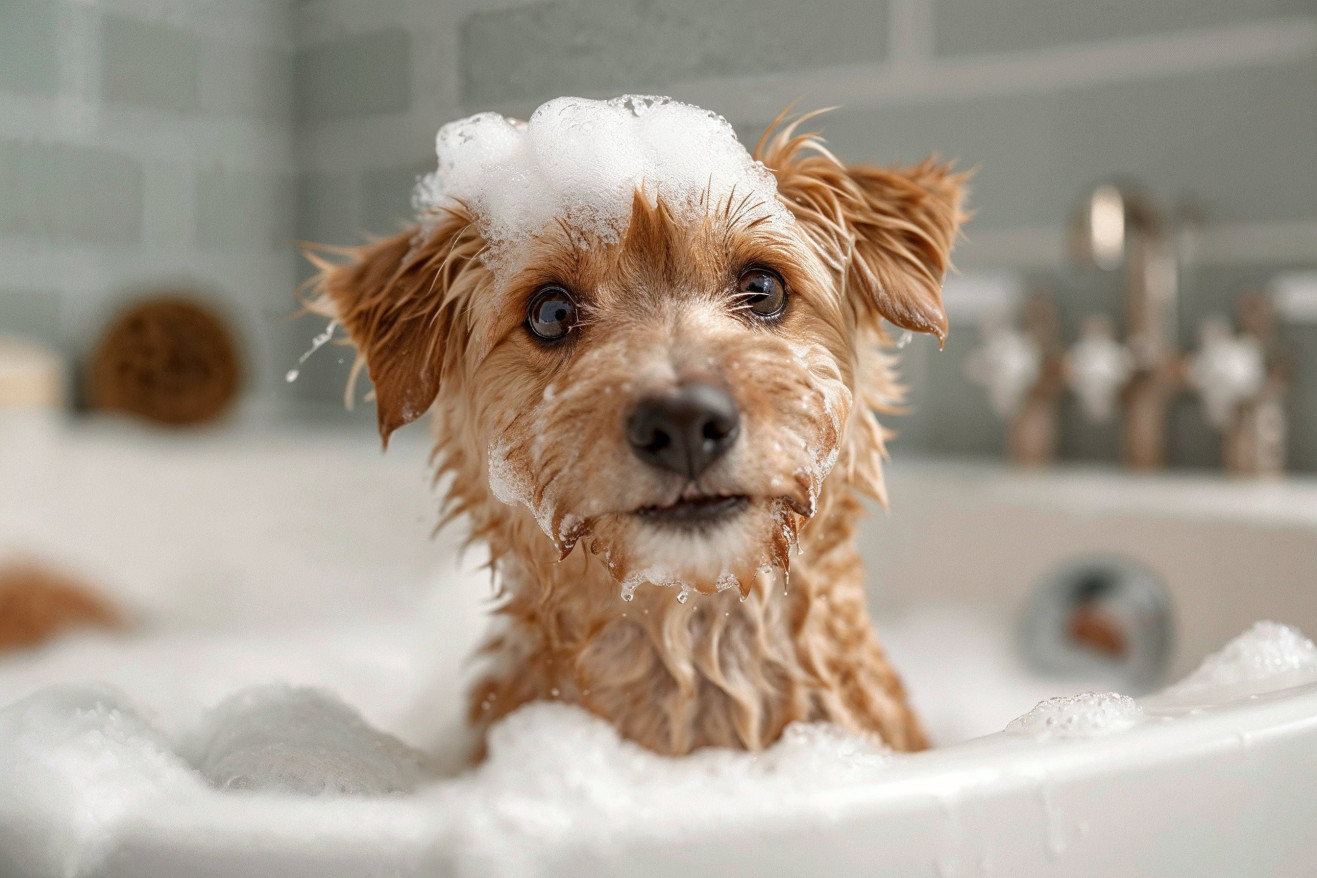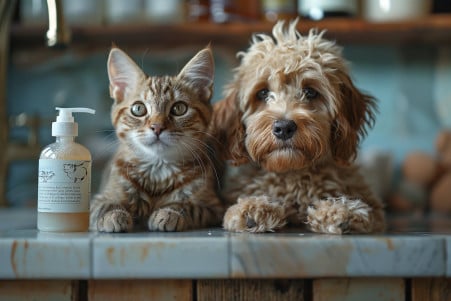How Often Should You Bathe Your Dog? Decoding Doggy Bathing
24 January 2024 • Updated 7 February 2024

Like many things in life, the answer to this question is not black and white. The frequency with which you should bathe your dog can depend on a number of factors, including your dog’s breed, coat type, and skin condition.
That said, most experts agree that the average dog should be bathed somewhere between once a month and once every three months. If your dog has a skin condition or allergies, you should talk to your vet to determine the best bathing schedule for your pet.
This article will explore the topic from a number of different angles, including insights from veterinarians and pet care professionals. We will also look at the latest research in the field of canine dermatology and the biological needs of different dog breeds and coat types.
Our goal is to give you a well-rounded understanding of the topic so that you can keep your dog’s coat clean and healthy while also making sure that your dog is happy and comfortable.
How often should you bathe your dog?
Adjusting Bath Frequency Based on Your Dog’s Coat
The length and texture of your dog’s coat will play a big role in how often they need to be bathed. According to the American Kennel Club and Pretty Paws LLC, dogs with short, smooth coats like Beagles and Boxers can go longer between baths, and a good wipe down can help keep them clean.
Meanwhile, dogs with long, curly, or oily coats like Poodles or Cocker Spaniels will need to be bathed more frequently, every four to six weeks, according to BeChewy and celebrity dog groomer Jorge Bendersky.
Dogs with double coats, like Siberian Huskies and Golden Retrievers, have their own special bathing requirements. In general, experts recommend only bathing dogs with double coats, like Siberian Huskies and Golden Retrievers, when they need it to avoid interfering with the coat’s natural insulation.
Regular grooming, including brushing and trimming, is especially important for these dogs to help extend the time between baths by preventing matting and keeping the coat clean, according to the ASPCA.
In general, make sure to adjust your dog’s bathing schedule based on their coat type and condition, and use these factors to help you determine how often you should bathe your dog. Sticking to a regular grooming schedule can help keep your dog’s coat healthy and free of mats, which may help you avoid frequent baths.
Adapting Bathing to Your Dog’s Lifestyle and Environment
Just as people change their bathing routines based on their lifestyles, it’s important to take your dog’s lifestyle into account when deciding how often to bathe them.
If your dog is active and loves to play outside, they’re going to get dirtier and need more baths. As the American Kennel Club explains, a trip to the dog park or a hike in the woods can leave your dog in need of a bath.
On the other hand, dogs that are less active or spend most of their time indoors, like a French Bulldog, may need fewer baths because they stay cleaner longer.
The environment is also a factor. Dogs that live in the city may be exposed to more pollutants and dirt on city streets, while dogs that live in the country may be more likely to get dirty from mud and burrs.
In both cases, the American Kennel Club and BeChewy say that the more your dog is exposed to the elements, the more often they’ll need a bath.
In addition, the seasons can also play a role in how often you need to bathe your dog, with the potential for more baths in the spring when it’s muddy and fewer baths in the winter when it’s drier and colder. By paying attention to these environmental factors, you can make sure your dog is clean without bathing them too often, which can lead to skin problems.
Skin Health: Common Skin Issues That Impact Bathing Schedules
Keeping your dog’s skin healthy is a fine line, and it can be impacted by a number of skin issues that may require you to adjust your dog’s bathing schedule.
If your dog has allergies, skin infections, or seborrhea (oily skin), you may need to bathe them more often with special shampoos. For example, dogs with skin problems can benefit from medicated shampoos, which can help them heal and feel better. Therefore, these issues can cause you to bathe your dog more often to help them manage their symptoms.
Sondel Family Veterinary Clinic notes that dogs with skin issues like skin allergies or parasites should be bathed on a schedule that includes medicated baths. According to Daily Paws, while dogs with healthy skin can tolerate frequent baths, dogs with skin issues should stick to a schedule that’s recommended by their vet to avoid making their skin problems worse.
It’s important to keep an eye on your dog’s skin for signs of distress, including excessive itching, redness, or lumps, which may indicate that you need to take your dog to the vet and put them on a special bathing schedule. To make sure that your dog’s skin is healthy and that they’re comfortable, work with your vet to determine how often you should bathe your dog and which products you should use.
How to Choose the Best Dog Shampoo: Ingredients and Formulations
Choosing the right shampoo is important for the overall health of your dog’s skin and coat. Dogs have a different skin pH than humans, so it’s important to use a dog-specific shampoo to avoid irritation and dryness.
The American Kennel Club recommends that the best dog shampoos are made with natural ingredients and are soap-free to help moisturize the skin. It’s also important to avoid parabens, dyes, and synthetic fragrances, which can lead to skin irritations and other health problems.
When choosing a shampoo, it’s important to read the labels. You want to find a product that is gentle but also strong enough to remove dirt without stripping the skin of its natural oils. The American Kennel Club also recommends looking for shampoos that are designed to penetrate thick coats and reach the skin, especially for dogs with double coats.
When bathing your dog, it’s important to make sure that you apply the shampoo properly and that you rinse thoroughly.
As the Veterinary Information Network points out, if you don’t rinse thoroughly, you can leave behind shampoo residue that can lead to skin irritation.
If you’re using a medicated shampoo to treat a skin condition, it’s also important to make sure that you leave the shampoo on for the recommended amount of time to make sure that the active ingredients have time to work. Making sure that your dog is clean and comfortable not only helps their physical health but also helps them be more eco-friendly when they step out into the world—or your living room.
Earth-Friendly Baths: How to Choose Dog Shampoo That’s Good for Your Pup and the Planet
If you’re a pet parent, you know that it’s important to be mindful of the products you use on your furry friend. When it comes to dog shampoos, using biodegradable options can help keep waterways clean. Pure Earth Pets notes that eco-friendly dog shampoos should be free of harmful chemicals like synthetic fragrances, sulfates, and phosphates, which can be toxic to marine life and even your pet.
In addition to looking for biodegradable options, Environment 911 suggests that you choose grooming products that are made with natural and organic ingredients like coconut oil and aloe vera, which are better for your dog’s skin and the environment.
Plus, the packaging that grooming products come in can also help cut down on plastic waste. For example, Grove Collaborative’s Good Fur line is committed to sustainability and uses recyclable aluminum bottles with reusable pumps for its grooming products.
If you’re more of a do-it-yourselfer, Martha Stewart has a recipe for homemade dog shampoo that you can make at home, which can help you control the ingredients and cut down on waste. By making sure that the dog grooming products you use are good for the environment, you can make sure that you’re taking care of your pet and doing your part to help protect the planet.
Stress-Free Suds: Canine Bathing Behavior Explained
Bathing can be a stressful experience for many dogs, so it’s important to understand the psychological and behavioral factors that can impact your dog’s reaction to the process.
Bath anxiety can be caused by a fear of water, a lack of familiarity with the process, or a history of negative experiences. Only Natural Pet recommends that you start with desensitization, which can include getting in the tub without water and using positive reinforcement like treats and praise to help your dog feel more comfortable.
Cesar Millan says that it’s important for dog owners to maintain a calm, assertive energy during bath time so that they can help influence their dog’s reaction. Dogs are very good at reading body language, so if you can stay relaxed, it can help your dog feel more at ease.
As Preventive Vet points out, positive reinforcement is the best way to change your dog’s emotional response to bath time. You can even use high-value treats and their favorite toys to make bath time a positive experience.
It’s also important to know the signs of stress in your dog, which can include shaking or trying to avoid the area where you bathe them, and to work through these issues with patience and consistent, gentle reassurance. If you do this, you can turn bath time into a bonding experience that will improve your dog’s mental and physical health and help you take a more well-rounded approach to their health and wellness.
A Happy and Healthy Friend: Conclusions About Bathing Your Dog
As you can see, how often you bathe your dog is based on a number of factors that are specific to your dog. From their coat type to their daily activities, these factors combine to determine how often your dog needs to be bathed. That said, short-coated dogs can often be bathed once a month, while long-haired or active dogs may need to be bathed more often, usually every four to six weeks.
Dogs with special needs or skin issues require a vet’s care. A vet can make sure that you’re keeping your dog’s health in mind and can give you personalized recommendations.
That said, when it comes to choosing grooming products, it’s important to think about more than just your dog’s health. It’s also important to think about the environment. By choosing eco-friendly, biodegradable grooming products, you can make sure that you’re doing your part to keep the earth healthy as well.
Ultimately, the goal is to make sure that you’re keeping your dog clean while also keeping their needs in mind. By paying attention to what your dog needs and responding accordingly, you can make sure that bath time is a positive, stress-free experience for both of you. Enjoy the process of being a responsible pet owner, where every bath helps contribute to a healthy, happy life for your furry friend.


